System Settings
The entry point for system settings is shown below:

Prompt Management
"Prompt Management" is used to centrally manage the prompt content used by various functional points in the system. Administrators can version control prompts, switch active versions, or perform editing and copying operations through this module to flexibly adjust the prompt logic and expression content of each functional point.
Prompt Management List
The prompt management list displays the prompt information of all functional points currently in the system, including the following fields:
- Function Point Name: The business function name corresponding to the prompt.
- Function Point Identifier: The unique identifier used internally by the system to recognize the function point, e.g.,
chatbi.genViewSchemaWithPrompt. - Current Active Version: The prompt version currently in use for this function point.
- Operations: Provides an entry for "Configure and Manage" to view, edit, and manage prompt versions.

Configure and Manage
Clicking "Configure and Manage" opens a detailed configuration dialog, with the interface divided into left and right parts:
Version Set Management
- Displays all prompt versions under this function point.
- Supports manually adding new versions, with a maximum of 4 versions per function point.
- Supports selecting the active version: only one version can be active under the same function point.
- Supports copying versions: allows one-click copying of an existing version's content to quickly create and modify a new version.
Prompt Content Editing
- Displays the prompt text content of the currently selected version (especially the active version);
- Administrators can directly edit the prompt text here, and saving updates the content of that version.
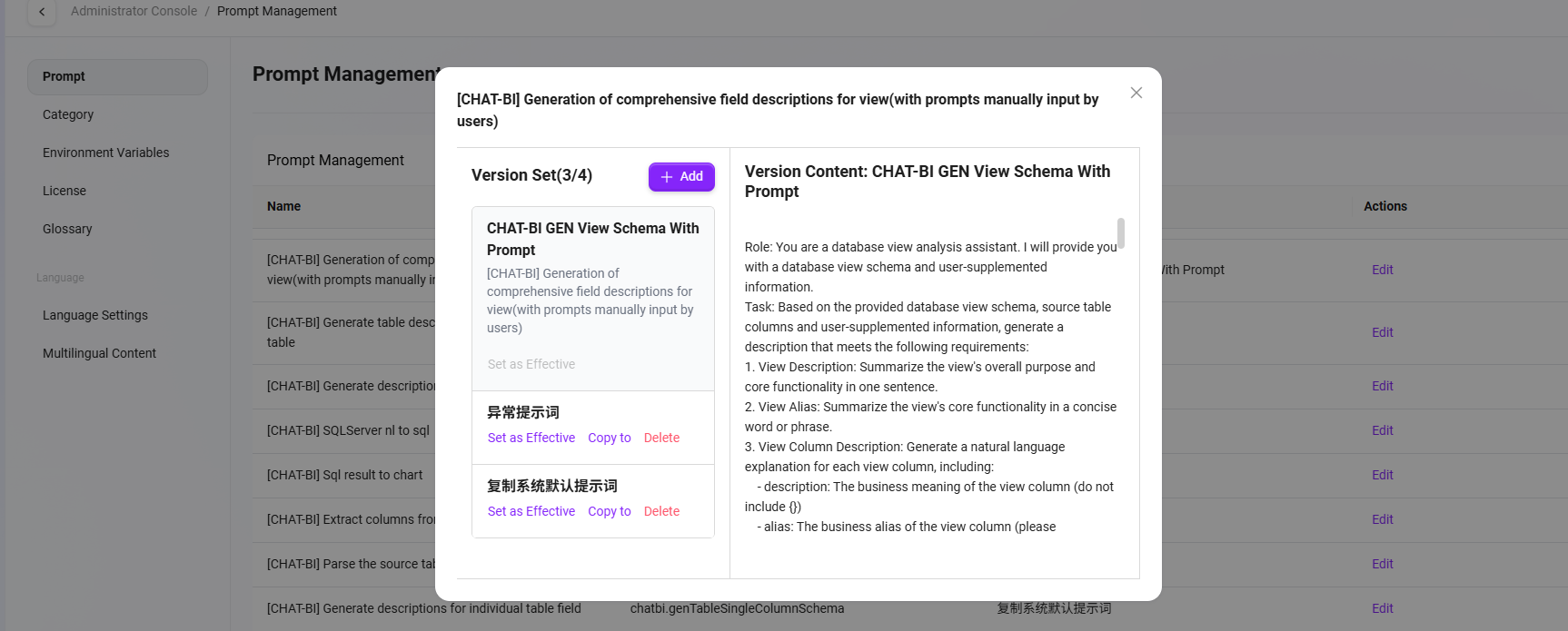
Usage Example
For example, the system function point identifier chatbi.genViewSchemaWithPrompt indicates that this prompt is used for system prompt logic when generating view structures in the ChatBI module. Administrators can create multiple versions under this function point (such as Test Version, Official Version), and after verifying the content effect, manually select one version as active to flexibly control the application of different prompt versions.
Category Management
Administrators can manage SERVICEME Assistant Categories and Application Categories in category management. Category management allows administrators to add, edit, view, and delete categories to ensure the tidiness and effective use of categories.
View Category List
- Enter the Category Management Page: Select "Category Management" in system settings to enter this page.
- View Categories: The category list displays category information in different language versions, including Japanese, Traditional Chinese, Simplified Chinese, and English, as well as descriptions for each category.
- Perform Operations: Administrators can edit or delete each category. Click the corresponding "Edit" button to modify category information, or click the "Delete" button to remove the category.

Add Category
- Click the "New" Button: Navigate to Settings > System Settings > Category Management and click the "New" button on the right to start adding a new category.
- Fill in Category Information:
- Category Name: Specify a unique name for the category. Fill in category names in different language versions, including Japanese (ja-JP), Traditional Chinese (zh-TW), Simplified Chinese (zh-CN), and English (en-US).
- Category Description: Provide a detailed description of the category to ensure it is easy to identify and use.
- Click "Save": After filling in all necessary information, click the "Save" button to create the new category.
💡 Tip: Supports one-click completion of names in different languages

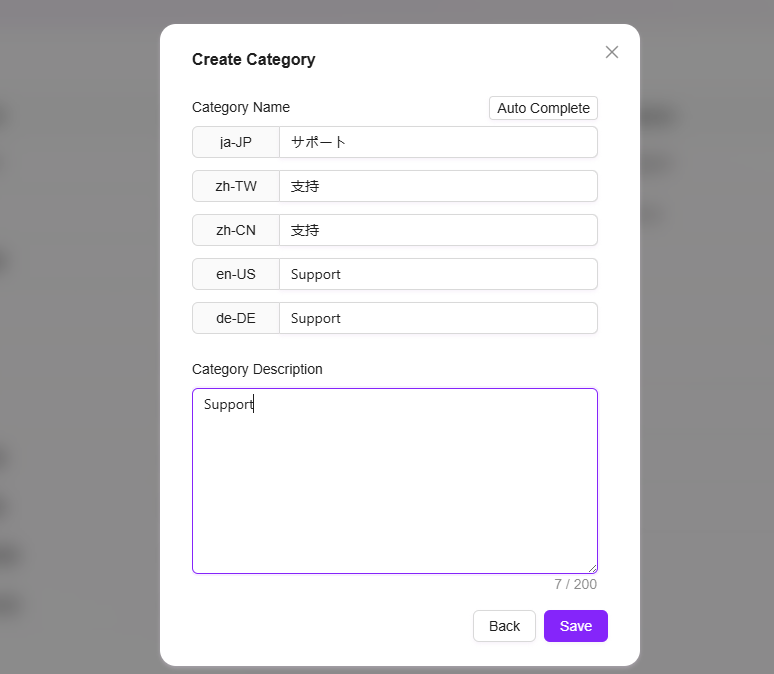
Edit Category
- Select the Category to Edit: Choose the category to edit from the category list.
- Click the "Edit" Button: Enter the edit page where administrators can modify the category name, description, and other content.
- Save Changes: After editing, click the "Save" button to update the category information.
Delete Category
- Select the Category to Delete: Choose the category to delete from the category list.
- Click the "Delete" Button: Click "Delete" and confirm to remove the category.

Environment Variable Management
Administrators can manage environment variables in the system, which are used to configure the system's operating environment. Through environment variables, administrators can set specific configuration items such as upload file size limits, supported file types, etc.
View Environment Variable List
- Enter the Environment Variable Management Page: Navigate to Settings > System Settings > Environment Variables
- View Configured Environment Variables: The system lists all configured environment variables, including each variable's name, value, module, and remarks.
- Examples: Environment variables such as
TITLE_FILTER,logo,slides_type, etc., can be viewed in the list.
- Examples: Environment variables such as
Add Environment Variable
- Click the "New" Button: On the environment variable management page, click the "New" button on the right to start creating a new environment variable.
- Fill in Environment Variable Information:
- Environment Variable Name: Specify a unique name for the new environment variable.
- Environment Variable Value: Assign a corresponding value to the environment variable. For example, the value of
slides_typecan be["Proposal seeking endorsement", "Information sharing"]. - Module: Select which module the variable belongs to (e.g.,
frontendorbackend). - Remarks: Enter remarks to help other administrators understand the purpose of the environment variable.
- Click "Save": After filling in all information, click the "Save" button to successfully create the new environment variable.
Edit Environment Variable
- Select the Environment Variable to Edit: Choose the item to edit from the environment variable list.
- Click the "Edit" Button: Enter the edit page where administrators can modify the variable's name, value, module, etc.
- Save Changes: After editing, click the "Save" button to update the environment variable.
Delete Environment Variable
- Select the Environment Variable to Delete: Choose the environment variable to delete from the list.
- Click the "Delete" Button: After confirmation, the environment variable will be deleted.

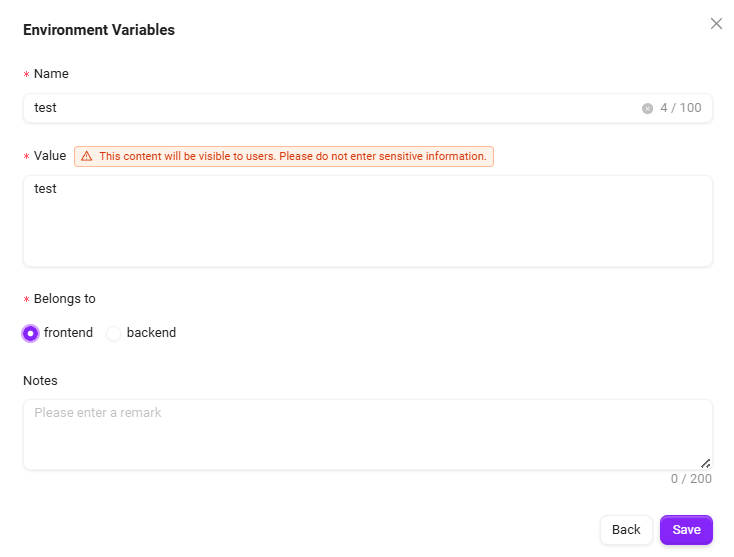
License Management
"License Management" is used to display and manage the current system's authorization information, ensuring the platform operates within the legally authorized scope. Administrators can view license details and usage through this interface and manually upload new license files when authorization expires or needs updating.
The license management interface mainly displays the following information:
- System Status: Shows whether the current system is activated.
- Environment Unique Code: A unique identifier automatically generated by the system to distinguish different deployment environments.
- Issue Date: The license issuance date, used to track the start of authorization.
- Expiration Date: The current license expiration date; system functions will be restricted after expiration.
- Remaining Agent Count: Displays the number of Agents that can still be created or used under the current license.
- Remaining User Count: Displays the number of users that can still be added under the current authorization.

License Update
When the license is about to expire or the authorized quantity changes, it can be updated as follows:
- Click the "Update License" button;
- In the pop-up window, select the new license file;
- After successful upload, the system will automatically verify and apply the latest authorization information.
Glossary
The glossary is used to centrally manage proprietary terms, terminology translations, and synonym mappings used within the project or enterprise, helping AI maintain terminology consistency and understanding accuracy during retrieval, Q&A, and text processing. Administrators can import terminology data by uploading standardized glossary files, and the system will prioritize glossary content when building indexes or performing semantic matching.
Supported Formats and Restrictions
- File Format: Only supports CSV (Comma-Separated Values) format.
- Maximum Upload Quantity: 1 file (only one glossary file can be uploaded at a time; to replace, delete the old file first before uploading a new one).
- Single File Size Limit: 10 MB.
- Recommended Encoding: UTF-8 (to avoid issues with Chinese or special characters due to encoding).
- Field Suggestions: It is recommended to include columns such as "Term", "Alias/Synonym", "Definition", "Language", with the first row as field names.

Language Configuration Management
Administrators can configure languages in the system. Currently, SERVICEME supports Japanese, Traditional Chinese, Simplified Chinese, and English. Administrators can add, edit, or delete languages according to actual needs.
Add Language
- Navigate to the Language Configuration Page: Enter "System Settings" and select "Language Configuration".
- Click "Add New": Click the "Add New" button on the right side of the page to start adding a new language.
- Enter Language Information:
- Language Code: Fill in the unique identifier for the language.
- Language Title: Enter the name of the language.
- Confirm Creation: Click the "Confirm" button to successfully add the new language.
💡 Tip: Newly added system languages need to be within the range of 46 language codes.
 换
换
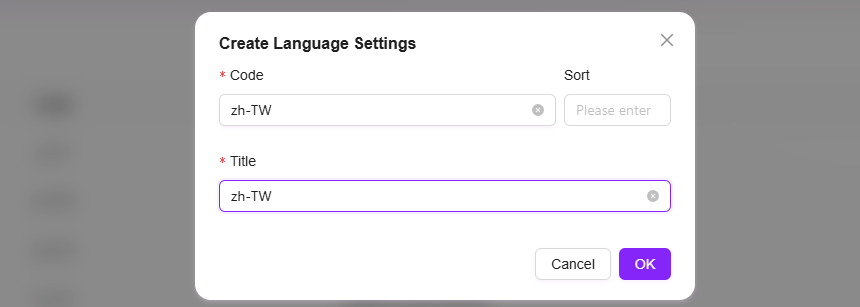
Edit Language
- Select the Language to Edit: Choose the language to modify from the language list.
- Click "Edit": Enter the language editing page.
- Modify Language Information:
- Editable content includes Language Title and Language Code.
- Save Changes: Click the "Save" button to update the language information.
Delete Language
- Select the Language to Delete: Choose the language to delete from the language list.
- Click "Delete": Click the "Delete" button on the right.
- Confirm Deletion: After confirmation, the language will be successfully deleted.

Multilingual Content Configuration
Administrators can configure multilingual content in the system, supporting management and editing of multiple languages. The following are related operation steps and instructions:
View Multilingual Content Configuration
- Enter the Multilingual Content Configuration Page: Administrators can find the "Multilingual Content Configuration" option in system settings and enter this page.
- View Configured Content: In the table, administrators can view the configured content for each language, supporting display of translations in different language versions.
- The table lists the configuration item name, content for each language (such as Japanese, Traditional Chinese, Simplified Chinese, English, etc.), and corresponding operation buttons like "Edit" and "Delete".
- Perform Operations: Administrators can edit or delete each row of content by clicking the corresponding "Edit" button to modify language content or the "Delete" button to remove unwanted configuration items.
- Write Protection: For built-in or critical configuration items, the system supports a "write protection" feature. Once a configuration is write-protected, it cannot be directly edited or deleted to prevent accidental operations. To modify such content, write protection must be removed first or unlocked by the system administrator.
Add Multilingual Content
- Click the "Add New" Button: On the multilingual content configuration page, click the "Add New" button on the right to start creating a new multilingual configuration.
- Fill in the Code: Specify a unique code for the new configuration item to ensure it can be correctly identified.
- Enter Titles for Each Language: Input titles for each supported language. Currently supported languages include:
- Japanese (ja-JP)
- Traditional Chinese (zh-TW)
- Simplified Chinese (zh-CN)
- English (en-US)
- Click "Confirm": After filling in all necessary information, click the "Confirm" button to save the configuration item and successfully add new multilingual content.
 换
换
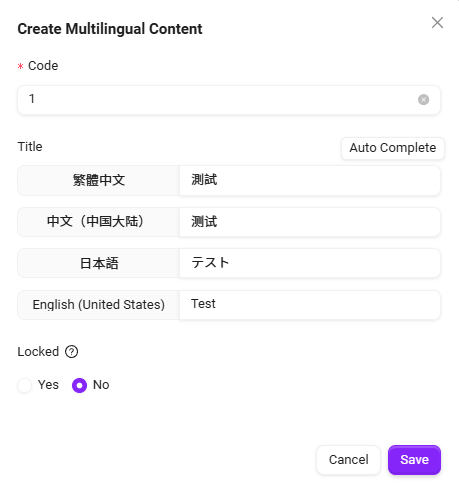 换
换
Import and Export
-
Import Multilingual Content:
- Administrators can click the "Import" button at the top right of the page to batch import prepared multilingual configuration files into the system.
- File formats are usually CSV or Excel and must include columns for Code and content for each language.
- During import, the system automatically validates data format and field completeness. For duplicate codes, options to overwrite or skip are available.
-
Export Multilingual Content:
- Click the "Export" button to export the current multilingual configuration items in the system as a file for backup or reuse in other environments.
- The exported file includes content for all languages and supports CSV or Excel formats.
-
Download Import Template:
- The system provides a standard import template, which can be downloaded by clicking the "Download Import Template" button.
- The template contains standardized field names (such as Code, ja-JP, zh-TW, zh-CN, en-US). Administrators can directly fill in content in the template and then import it to ensure correct formatting.
